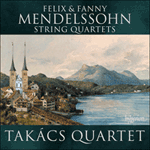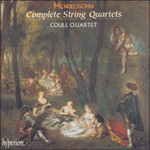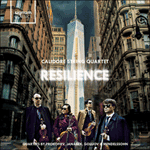
Welcome to Hyperion Records, a British classical label devoted to presenting high-quality recordings of music of all styles and from all periods from the twelfth century to the twenty-first.
Hyperion offers both CDs, and downloads in a number of formats. The site is also available in several languages.
Please use the dropdown buttons to set your preferred options, or use the checkbox to accept the defaults.
Throughout much of Op 80 Mendelssohn animates his requiem for his sister, as the work is often interpreted, with startling discontinuities and agitated clashes. Barely holding the whole together is motivic and thematic material that privileges the dissonant interval of the diminished fourth (A flat down to E natural, the leading note of the F minor home key), often associated with the stronger, deeper emotions. Of particular note is the jarring scherzo, which takes on a sinister, macabre quality through its driving syncopations and unrelenting chromaticism, perhaps fulfilling vicariously Mendelssohn’s earlier prediction in February 1847 that his sister would someday compose a ‘scherzo serioso’.
Only the adagio in A flat major offers some solace from the F minor tonality that dominates in the other three movements. In the adagio, Mendelssohn once again approaches the world of song, and the interior, private world of his sister’s musical genius.
from notes by R Larry Todd © 2021
Dans une bonne partie de l’op.80, Mendelssohn anime son requiem pour sa sœur, comme cette œuvre est souvent interprétée, avec des ruptures saisissantes et des heurts agités. Assurant à peine la cohésion de l’ensemble, les motifs et le matériel thématique privilégient l’intervalle dissonant de la quarte diminuée (la bémol–mi naturel), souvent associée à des émotions plus fortes et plus profondes. Il convient de souligner le scherzo discordant, qui prend un ton sinistre et macabre par le biais de ses syncopes pressantes et de son chromatisme implacable, réalisant peut-être par personne interposée la prédiction antérieure de Mendelssohn en février 1847 selon laquelle sa sœur allait un jour composer un «scherzo serioso».
Seul l’adagio en la bémol majeur console un peu de la tonalité de fa mineur qui domine dans les trois autres mouvements. Dans l’adagio, Mendelssohn approche une fois encore l’univers du Lied, et le monde intérieur et privé du génie musical de sa sœur.
extrait des notes rédigées par R Larry Todd © 2021
Français: Marie-Stella Pâris
Mendelssohns Streichquartett op. 80—das oft als Requiem für seine Schwester aufgefasst wird—enthält viele bestürzende Brüche und aufgewühlte Kollisionen. Das motivische und thematische Material, in dem das dissonante und oft mit stärkeren, tieferen Emotionen assoziierte Intervall der verminderten Quarte (As–E) immer wieder vorkommt, vermag das Ganze kaum zusammenzuhalten. Besonders hervorzuheben ist das erschütternde Scherzo, das durch seine treibenden Synkopen und die unerbittliche Chromatik unheimlich und makaber anmutet und vielleicht indirekt Mendelssohns frühere Vorhersage vom Februar 1847 erfüllt, dass seine Schwester eines Tages ein „Scherzo serioso“ komponieren würde.
Nur das Adagio in As-Dur bietet etwas Balsam inmitten des f-Moll, das in den anderen drei Sätzen dominiert. Im Adagio nähert sich Mendelssohn noch einmal der Welt des Liedes und der inneren, persönlichen Welt des musikalischen Genies seiner Schwester.
aus dem Begleittext von R Larry Todd © 2021
Deutsch: Viola Scheffel
 Mendelssohn & Mendelssohn (Fanny): String Quartets Mendelssohn & Mendelssohn (Fanny): String QuartetsFelix’s impassioned F minor quartet was the fiercely personal response to his sister’s death in 1847, only a few months before his own. The Takács Quartet frames it with equally committed accounts of a much earlier work, and Fanny’s own important ...» More |
 Mendelssohn & Mendelssohn (Fanny): String Quartets - Vinyl Edition Mendelssohn & Mendelssohn (Fanny): String Quartets - Vinyl EditionFelix Mendelssohn’s impassioned F minor quartet was the fiercely personal response to his sister’s death in 1847, only a few months before his own. The Takács Quartet introduces it with an equally committed account of Fanny’s own important contrib ...» More |
 Mendelssohn: The Complete String Quartets Mendelssohn: The Complete String Quartets‘Wonderful music … beautifully presented and expertly annotated’ (Gramophone) ‘The overwhelming impressions … are of high spirits and clarity of texture combined with excellent ensemble and sensitive musicianship’ (CDReview)» More |
 Resilience ResilienceThe Calidore String Quartet makes its Signum debut with a programme of four string quartets, by Janáček, Prokofiev, Golijov and Mendelssohn, each work representing for the performers something of the best of the human spirit as their composers att ...» More |

